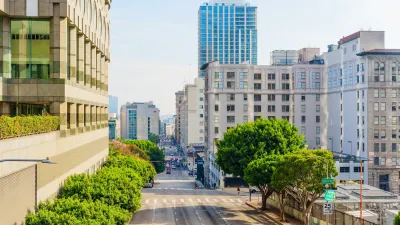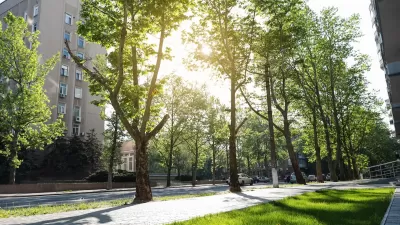The County of Los Angeles Chief Sustainability Office is leading the effort to prepare the county's first Urban Forest Management Plan.

Made up of trees on both public and private lands, the urban forest is an essential part of a healthy, thriving, and resilient community. When spread equitably and supported by other urban greening measures, a well-managed urban forest throughout Los Angeles County can deliver a wide range of benefits, such as healthier soils, biodiversity, habitats, shading from heat, and greater community health and well-being.
The County of Los Angeles Chief Sustainability Office (CSO) is leading the effort to develop an Urban Forest Management Plan (UFMP) which is a blueprint that will guide the planting of new trees and the protection of mature trees throughout the region. OurCounty, L.A. County's Sustainability Plan, calls for the development of the UFMP to ensure a climate-appropriate, healthy urban tree canopy that is equitably distributed. A key goal for the UFMP is to address inequities in the distribution of trees and tree canopy as well as the benefits they offer. Research shows that lower-income neighborhoods and communities of color often have less tree canopy.
In this article, CSO policy analyst Rebecca Ferdman addresses the following important questions and more:
- Compared to most major urban areas, does L.A. have a relatively healthy urban forest?
- Why are trees so important? Both from an ecological point of view and a quality of life point of view?
- What role do trees play in climate change? How can they help us adapt to rising temperatures, wildfires and the like?
- What can we do to make sure that all residents benefit from vibrant tree canopies?
- What kind of trees should we be planting in our communities?
- Is the iconic palm tree maybe a thing of the past?
- What is driving the County's UFMP and what do you hope to achieve?
To learn more, please read the source article.
FULL STORY: Putting Down Roots

Planetizen Federal Action Tracker
A weekly monitor of how Trump’s orders and actions are impacting planners and planning in America.

Congressman Proposes Bill to Rename DC Metro “Trump Train”
The Make Autorail Great Again Act would withhold federal funding to the system until the Washington Metropolitan Area Transit Authority (WMATA), rebrands as the Washington Metropolitan Authority for Greater Access (WMAGA).

The Simple Legislative Tool Transforming Vacant Downtowns
In California, Michigan and Georgia, an easy win is bringing dollars — and delight — back to city centers.

The States Losing Rural Delivery Rooms at an Alarming Pace
In some states, as few as 9% of rural hospitals still deliver babies. As a result, rising pre-term births, no adequate pre-term care and "harrowing" close calls are a growing reality.

The Small South Asian Republic Going all in on EVs
Thanks to one simple policy change less than five years ago, 65% of new cars in this Himalayan country are now electric.

DC Backpedals on Bike Lane Protection, Swaps Barriers for Paint
Citing aesthetic concerns, the city is removing the concrete barriers and flexposts that once separated Arizona Avenue cyclists from motor vehicles.
Urban Design for Planners 1: Software Tools
This six-course series explores essential urban design concepts using open source software and equips planners with the tools they need to participate fully in the urban design process.
Planning for Universal Design
Learn the tools for implementing Universal Design in planning regulations.
Smith Gee Studio
City of Charlotte
City of Camden Redevelopment Agency
City of Astoria
Transportation Research & Education Center (TREC) at Portland State University
US High Speed Rail Association
City of Camden Redevelopment Agency
Municipality of Princeton (NJ)





























